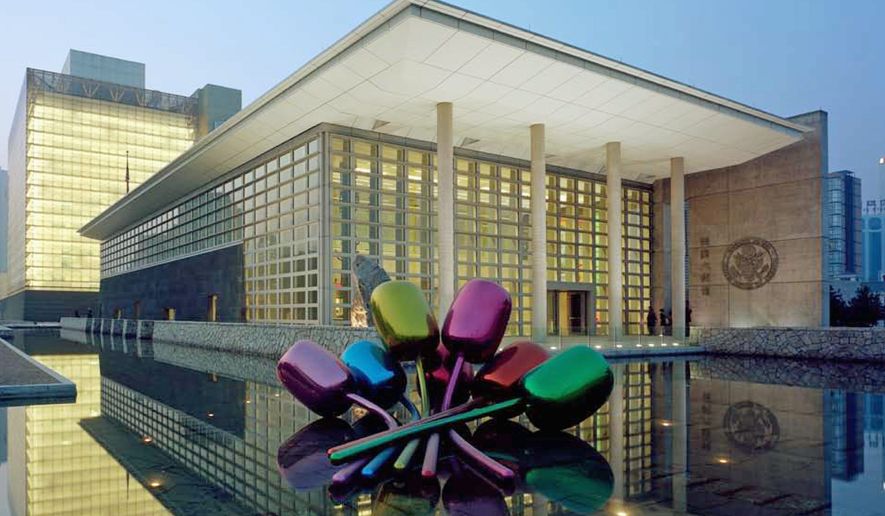The Chinese may be wary of America’s global intentions, but they certainly like our art.
Since earlier this year, when works by American artists were installed in the new U.S. Embassy compound in Beijing, there is an ever-lengthening waiting list to join the weekly tours. The visitors gaze at the vast ceramic wall installation by artist Betty Woodman and, among other works, Jeff Koons’ oversize, balloonlike “Tulips” floating in a pond and Chinese artist Cai Guo-Qiang’s “Eagle on a Branch,” created by spreading gunpowder and detonating it.
The permanent exhibition is one of more than 50 created in U.S. Embassies around the world by the State Department through its venerable Art in Embassies program, a much-lauded vehicle for the projection of U.S. “soft power” through fine art.
Launched 50 years ago by President John F. Kennedy, the program’s brand-building message is simple: There’s more to American culture than fast food, reality TV and the antics of Lindsay Lohan.
The permanent exhibitions are a relatively recent initiative, added to Art in Embassies’ core function — helping newly appointed U.S. ambassadors or chiefs of mission choose American works of art to exhibit in the rooms of the embassy residence where they entertain and receive guests. The residence of the chief of mission is usually a separate venue from the embassy — also called the chancery — which is the actual place of business.
Working with Art in Embassies curators, the newly nominated ambassador in effect creates an instant art collection that accompanies him or her to the new foreign post.
The program is the envy of the diplomatic world, where it has been studied and copied; and the State Department cherishes it as a valuable, high-end part of its cultural outreach effort. Secretary of State Hillary Rodham Clinton, in a message in the glossy catalog of each exhibition prepared for distribution by the embassy, says the program “intrigues, educates, and connects — playing an ambassadorial role as important as that served by traditional diplomacy.”
There can be little the State Department does that compares with the cost-effectiveness of the program, which is proud to cost not even half a percent of the department’s budget.
At any given time, some 5,000 works are on display in about 200 residences in 180 countries. But most are on short-term loan from museums, galleries, collectors — or the artists themselves — across the United States.
The range of artists varies enormously, with major embassies tending to get the more-distinguished American masters, in part as a matter of prestige. The U.S. Embassy collection in London, for example, includes works by Mark Rothko, Cy Twombly, Jasper Johns, and Willem de Kooning. The embassy in Conakry, Chad, has works by basket weavers Mary Jackson and Deborah Muhl, and quilt maker Jean Wells.
“We strive to include undiscovered and emerging talent as well as mid-career and recognized artists,” said Virginia Shore, the program’s deputy director and chief curator.
The new, permanent embassy exhibitions involve some acquisitions, but with the emphasis on younger up-and-coming artists. Collections also have begun to include some works by artists from the host country.
“It’s a cultural exchange program,” Ms. Shore said. “The program’s objective is to show the range of both the host country and the United States.
The most recent collection on display at the U.S. Embassy residence in Seoul, for example, focused on Korean-American artistic connections, including photographs by Korean sculptor Do Ho Suh, and works by artist Nam June Paik. The program’s collection in the American Embassy in Malta is almost evenly divided between American and Maltese artists.
Confronted with the prospect of becoming art collectors, some ambassadorial nominees need more help than others. One unnamed envoy recently was quoted as saying the experience was “a bit like speed-reading ’Moby Dick’.”
To mark its 50th birthday, the Art in Embassies program is reaching out in some novel ways. It has sponsored a lecture series on American art at the Tate Modern in London and put out — through the Defense Department — a call for photographs of active duty and former members of the armed forces who have served overseas for a video piece by Chicago video artist Lincoln Schatz.
“It’s an example of using our visual power,” said Beth Dozoretz, the Washington business executive and major Democratic Party fundraiser who became director of the Art in Embassies program a year ago. The piece will hang in the U.S. Embassy in Kabul, Afghanistan, she said.
Assuming, that is, we still have an embassy in Kabul once the troop pullout is complete.




Please read our comment policy before commenting.